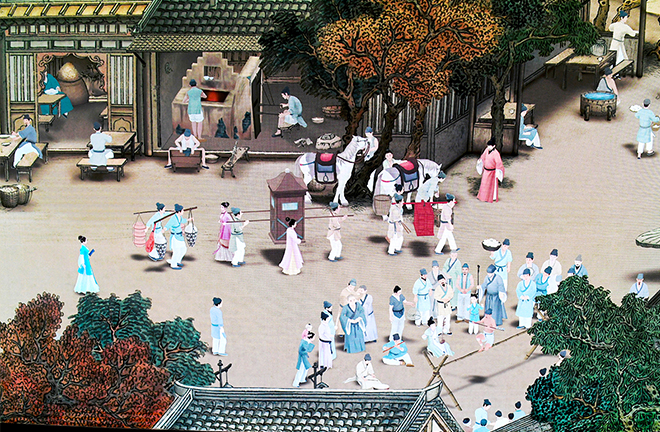Webinar explores Chinese social history education

Nanjing’s ancient life spanning thousands of years displayed at a digital exhibition in the Deji Art Museum in Nanjing, Jiangsu Province, Feb. 20 Photo: CFP
A webinar on the teaching of Chinese social history from the perspective of comprehensive pedagogy was held on April 9th.
Conceptual clarification
To clarify what social history is, we should start with “society.” According to Zhang Xiaochuan, a professor from the School of Social Development and Public Administration at Suzhou University of Science and Technology, the concept of “society” can be defined in a broad as well as a narrow sense. In a broad sense, “society” refers to the organic whole formed by people who are connected with each other according to certain norms of behavior on the basis of common material production activities. In a narrow sense, “society” refers to a series of phenomena produced by human beings as they form groups, which can be roughly understood as “the way of life.” Due to different understandings of “society,” there are differences in the concept of “social history” in academic circles, which is mainly reflected in the dispute between integral history emphasizing the broad concept of society and a special history highlighting the narrow concept of society.
There are varied opinions on the concept of “social history” in academic circles, leading to different focuses in the curriculum content design in colleges and universities. In the opinion of Wu Zhengqiang, an associate professor from the Department of History at Zhejiang University, social history is a discipline that analyzes social structure and social changes utilizing theories from sociology and the social sciences. In this sense, it should be classified as an integral history. In sociological theory, social structures involve subsystems such as social organizations, social relations, social culture, and social action. From this perspective, social history can be regarded as a special history, but its study still belongs within the scope of integral history. Therefore, course design should focus on social structures and the life history of the narrow concept of “society.” It is also necessary to establish such special courses as medical history and environmental history, which belong to the research category of “society” in the broad sense but have academic context different from traditional social history.
The question of whether life history should be included in social history courses has sparked heated debates. Chang Jianhua, a professor from the Faculty of History at Nankai University, said that current research on life history tends to integrate social history and life history, or emphasize that life history is distinct from social history. As the meaning of “social life” is vague and flexible, academic understanding of its connotation and extension is not unified.
Li Xiaomin, a professor from the School of History at Zhengzhou University, said that life history touches upon all parts of society that are connected by people’s lives as the core. Students can generate emotional connections with ancient peoples through understanding their life and then reflect upon their own life. From this educational perspective, social history courses should include life history.
Teaching mode
In social history teaching, most higher education institutions adopt “general theory” and “special topic” approaches in parallel. The general theory aims to clarify the development of Chinese society and the research process of Chinese social history, while special topics focus on specific content of social history. The two complement each other and help students build a relatively complete knowledge system.
The ultimate goal of social history research is to holistically grasp China’s social form and development process, among which historical periodization is a key issue, especially in general theory education. In Zhang’s view, according to the two basic elements of political pattern and social structure, the evolution course of Chinese society can be divided into four stages, namely the “feudal aristocratic society” during the Xia (c. 21th–16th century BCE), Shang (c. 16th–11th century BCE), and Zhou (c. 11th century BCE–221 BCE) dynasties; the “imperial scholar-bureaucrat society” from the Qin Dynasty (221–207 BCE) to the Five Dynasties (907–960); the “imperial four professions society,” composed of scholars, farmers, artisans, and merchants, from the Song Dynasty (960–1279) to the Qing Dynasty (1644–1911); and the “modern industrial society” since the Republican era (1912–1949). In teaching and research, the analysis of each social stage should be carried out from the four aspects of economic basis, political pattern, thought and culture, and social order, since the four aspects of a period are interdependent and obviously different from other periods.
In thematic education, higher education institutions set up different courses according to their own characteristics. According to Zhang, Suzhou University of Science and Technology offers such courses as “Children’s Concept and Childhood Education,” “Research on the History of New Material Culture,” and “Research on the History of Everyday Life.”
Wu suggested that the study of social history focus on real society and thereby raise questions pertaining to history. In creating thematic courses, college teachers should consciously strengthen relevant training.
When explaining the topic “Epidemics and Disaster,” Li assigned her students the task of “searching for and analyzing historical materials concerning the COVID-19 pandemic.” In this way, students are concerned about real life and simultaneously conduct historical research, feeling the relationship between individuals and society, and reality and history.
Edited by YANG LANLAN
